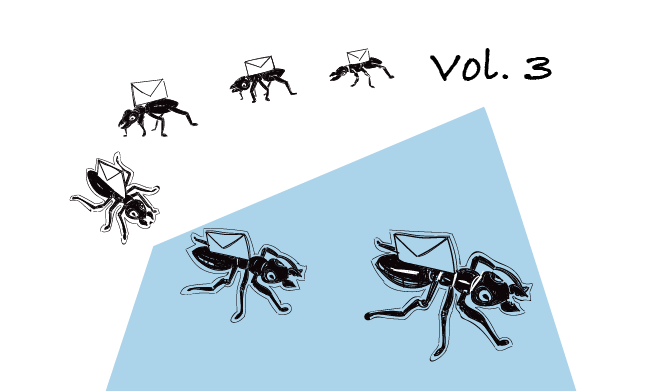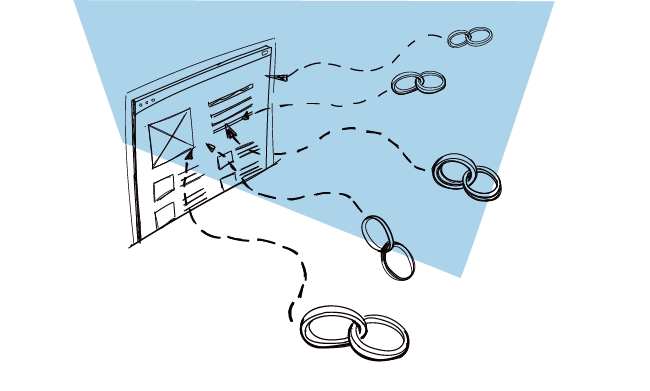You might have heard this joke:
‘What’s the best place to hide a body?’
‘Page 2 of Google’.
While it’s funny, it’s also true.
Businesses aim to be at the top of the search, and to get there their websites have to be top-notch.
Backlinks are one of the factors that determine the quality of a website. They affect how high your page will show in the search results for certain keywords.
That’s why I asked SEO expert Lukasz Zelezny for some pointers on how to get quality backlinks and move your website up in Google.
 He shared that there’s a whole lot of link building techniques – in this blog post I’ll show you how you can use some of them to bubble your site up in the search rank, while staying on good terms with Google.
He shared that there’s a whole lot of link building techniques – in this blog post I’ll show you how you can use some of them to bubble your site up in the search rank, while staying on good terms with Google. Why are backlinks important?
Links pointing from other websites to your website strengthen its authority.
The idea behind this is simple: it’s like someone recommending an ice cream flavor. The more people recommend it to you, the more you think it really must be delicious. And if most of these recommendations come from people you know and trust, then your conviction is even stronger, isn’t it?
The same goes for backlinks. If many websites point to your site, it’s a signal for Google that your website most probably is of good quality. And if many high-value websites point to your site, it’s an even stronger vote of confidence for your site.
Of course there’s more to backlinks than the fact that they’re an important puzzle of your SEO strategy: backlinks from frequently visited webpages drive traffic to your website.
It’s even better if the sites are topically related to yours – then a part of the traffic that gets diverted your way might actually result in converting your website visitors into customers.
So how do you get high-quality backlinks?
There are 3 important rules of link building:
- The no.1 rule is that first you need to have a good website that is worth linking to. (I assume you’ve already taken care of that part.)
- Never contact webmasters for the sole reason of getting a backlink. It might be harmful for your reputation and most probably won’t bring you satisfying results, either.
- Ask yourself this question: ‘What is the reason for my link to appear on this site?’. If you can’t think of any reasonable explanation other than: ‘My website will jump higher in the search’, then don’t even contact the site’s owner.
Having said that, here are some reasons why your link could appear on a site – along with tips on how to actually make it happen.
An unlinked brand mention
This is one of the easiest ways to bump up the number of backlinks.
What do you start with? First you need to gain more publicity. When your company/product is visible, more people will write about it online.
You can easily track these mentions with a social listening tool, such as Mention, Brand24 or Agorapulse. When you identify quality websites among all of the ones that mention your company/product, extract the data from the tool.
(On a side note, you can also use social listening tools to better personalize your emails. See how to do it in this blog post.)
Broken links
This strategy has two sides. It might mean:
- a broken link leading from another site to yours. If your link is a valuable one, the owner will probably appreciate you pointing out that it’s broken and will replace it with an active one
- a link on a high-quality website that pointed to a site/a piece of content topically related to your website/content. You may reach out to the website owner and offer them your link as a substitute
To find broken links, you might use a broken link checker, such as the Chrome extension Check My Links.
Links pointing to your social media
If you find someone linking to your Facebook, LinkedIn or Twitter profile, you might contact the owner and thank them – and ask politely if they would link to your website instead.
How to find such links? With tools such as Link Explorer.
Expert roundups
You may search for any upcoming roundups in your niche and ask to be a part of one. This might also work with those that have already been posted – as long as you offer a valuable opinion, there’s a chance the website owner will add your paragraph even after publishing the roundup.
Interviews, guest posts, customer case studies
Providing valuable content for someone else is always a good reason for getting a backlink, be it in the form of a blog post or an honest opinion about a tool you’re using.
This method might be a bit time consuming at times, but may result in highly valuable backlinks if you choose the websites wisely.
To find the right websites you may use Google (duh) or reach out to the ones you’re following and whose content you appreciate.
Resource pages
Aka, websites with a list of links pointing to valuable websites on a particular topic.
How to find such pages? Just type ‘(your niche) resource page’ in Google.
Can’t I just buy links?
No. I mean – you could, but Google is very strict about such behavior. Not only will your website be pushed down in the ranks, but you can actually get penalized if you do so.
The same goes for anything else, really – Google doesn’t allow offering anything in exchange for a backlink, be it money, free samples of your product or putting a link to the other website on yours. They see all of this as link manipulation.
If you’re wondering about what exactly falls under the term ‘link manipulating’, here’s a resource you might find helpful: Google Quality Guidelines.
Can link building be automated?
It can, but – as in the case of manipulating links – it’s the fast lane to being pushed down to the very end of the organic search results and even penalized by Google. There are some link building automation methods, but using them is questionable, so I won’t go that way.
It’s the quality of the backlinks that matters, not their quantity, so don’t try to automate the entire process. You may automate some parts of it, though, for example when you’re contacting webmasters who you’ve carefully selected before.
How to get in contact with webmasters?
Our expert suggests that on a small scale it’s best to use a contact form on the website. But if we have a large amount of email addresses to collect, we may use a tool to help us with the task, such as LinkAssistant, and then reach out to them using an email automation tool. I’ll explain how to create such a workflow and streamline the whole process in the next paragraphs.
What certainly won’t work when contacting webmasters?
Sending emails to people at random. Let me state this clearly: you need to have a reason for your link to appear on somebody’s site. And no, ‘I need it to push my website up in the search’ isn’t a good enough reason.
What else will annoy website owners?
Sending emails from a free email address. People might assume you have something to hide or are trying to scam them in some way. If you want to look professional, use a business email address, one with your company domain in it.
Since we know what NOT to do, let’s see what we CAN actually do to get quality backlinks for our website.
How to start link building?
One crucial thing you need to remember throughout the whole process is that website owners don’t owe you anything. They don’t HAVE to put your link on their website. If they decide to do so, it’s out of courtesy.
That’s why your sending strategy shouldn’t be aggressive.
STEP #1 Import webmasters’ data into Woodpecker and tag them
The more you personalize your emails, the higher the chance of getting a positive response. And it’s easier to personalize them if you segment your contact base.
Once you import the data, use tags to categorize it by link building methods, for example #brandmention, #brokenlinks, #guestpost and so on.
STEP #2 Set up an email sequence
How to create an email that gets opened and replied to?
You might use the link building method you’re employing in a particular case to create a compelling and original subject line. For example, you can go with something along the lines of ‘Thank you for mentioning my brand, {{First _Name}}!’.
What’s important is that the subject line should always be truthful. Don’t use clickbait. You might get the webmasters to open your email, but when they see that you fooled them, they’ll only get angry.
Now, when it comes to the email copy it’s important you’re writing not only for the purpose of getting a link. How would you feel if you got a message in which someone asks you to put their link on your website – and that’s all? Would you be willing to do it? I know I wouldn’t.
That’s why you need to add something more to your email: comment on their blog post, say you love their product (if that’s true) and thank them for mentioning your brand.
Here’s what an opening email might look like:
Hi {{First_Name}}, My name is Greg. I’m the Head of Marketing at Plethora. Recently I’ve stumbled upon your {{Content_Type}} about {{Topic1}} – a great read! I notice you mention us when writing about {{Part_of_Content}}. Thanks so much – it’s awesome to hear you guys {{Opinion_About_Plethora}}. If it’s not too much to ask, would you consider adding a link to our website in the {{Content_Type}}? We’d be super grateful! Best,
Greg
Head of Marketing at Plethora.co
Follow-up strategy
Sending follow-ups is fundamental for getting responses. After all, some webmasters might have forgotten to reply to you or they simply missed your message in their inbox. So if you want to be sure that you’re doing all that you can for your link building campaign to succeed, don’t forget about follow-ups.
As I’ve already mentioned, your sending strategy shouldn’t be too aggressive. 1-2 follow-up messages are a maximum in this case.
There’s a handy trick that you can use, though, to increase the chance of getting a reply: base your follow-ups on the website owners’ engagement.
How do you do it?
You compose an opening message and two versions of follow-up #1. This divides your campaign path into two routes: depending on the recipients’ action (e.g. if they opened the email or they haven’t) Woodpecker will send either one or the other version of a follow-up.
If you see that a website owner opened your email, but hasn’t responded, you might send him a message like this one:
Hello {{First_Name}}, loved your latest {{Content_Type}} on {{Topic2}} – I particularly liked the bit about {{Part_of_Content2}}. We at Plethora can certainly relate to that one. Thanks for creating such high-quality content and sharing it with us! As I’ve mentioned in my previous email, I also enjoyed your {{Content_Type}} about {{Topic1}}. Best,
Would you be willing to insert a link to our website in the part where you write about Plethora? I’d greatly appreciate it!
Greg
Head of Marketing at Plethora.co
And if you see that they haven’t opened your message, you may send them a follow-up such as this one:
Hi {{First_Name}}, I’m Greg. I’m the Head of Marketing at Plethora.co. A week ago I came across one of your {{Content_Type}} – the one about {{Topic1}} and I saw you mentioned Plethora in it. Thanks so much for doing so! We’re always happy to hear that our app provides value for people. Would you mind adding our link to the article? I think it might be useful for your readers – if they’d like to check out our website, they’d already have a shortcut to get there. We’d greatly appreciate it! Best,
Greg
Head of Marketing at Plethora.co
Personalizing your email sequences not only with custom fields, but also with condition-based follow-ups will help to propel your open and reply rates to new heights.
To sum up
The more high-quality websites vouch for your site, the more visible you’ll be in the search rank, which in turn may translate to more traffic – and ultimately more sales for your business.
Link building might seem like a lot of work at first, but once you acquire the first couple of valuable backlinks, they’ll be working for you even when you sleep.
FAQ
What Is Broken Link Building and How Can It Enhance My Link Building Strategy?
Broken link building involves finding links on other websites that no longer work and offering your own website as a replacement. This tactic not only helps site owners fix broken links but also allows you to gain quality backlinks. It’s a key part of a broader link building strategy, focusing on adding value and improving the web for users.
How Can I Use Resource Pages for Building Backlinks?
Resource pages are curated lists of links to helpful resources on specific topics. By finding resource pages that align with your content, you can reach out to the site owner with a suggestion to include your site as a resource. This method is effective for gaining high-quality links and increasing your site’s visibility in search engine results pages (SERPs).
Why Are Quality Links Important for My Website’s SEO?
Quality links from reputable and relevant sites signal to search engines that your content is valuable and trustworthy, which can boost your rankings in SERPs. High-quality links are more beneficial than a large quantity of low-quality links, as they contribute to the overall authority and credibility of your website.
Can Guest Posting Be an Effective Way to Build Backlinks?
Yes, guest posting on other websites in your niche is a highly effective way to build quality backlinks. By providing valuable content to another site, you can include contextual links back to your own site, which helps improve your search engine rankings and drives targeted traffic to your site.
How Does Internal Linking Support My Link Building Efforts?
Internal linking helps spread link equity throughout your site, making it easier for search engines to crawl and index your pages. By linking to your own content, you can improve user engagement, reduce bounce rates, and encourage visitors to explore more of your site, which indirectly supports your external link building efforts.
What Role Does Keyword Research Play in Link Building?
Keyword research is crucial for understanding what your target audience is searching for. By aligning your content and link building efforts with these keywords, you can increase the relevance and visibility of your site in search engine results, making it more likely to attract links from other sites.
How Can I Avoid Spammy Backlinks and Focus on Building High-Quality Links?
To avoid spammy backlinks, focus on earning links from reputable sites within your niche, use natural link building methods like creating amazing content, and engage in guest posting and broken link building. Regularly monitor your backlink profile using free online tools to identify and disavow any low-quality or spammy links.
What Are the Best Practices for Reaching Out to Site Owners for Link Building?
When reaching out to site owners, personalize your communication, clearly articulate the value your content adds to their site, and be concise and professional. Building relationships with site owners can be more effective than just asking for a link, as it opens the door for future collaboration.
How Many Backlinks Do I Need to See a Significant Impact on My SEO?
The number of backlinks needed varies depending on your industry, competition, and the current authority of your website. Instead of focusing on quantity, prioritize the quality and relevance of backlinks. Even a few high-quality backlinks can have a significant impact on your SEO.
How Can Free Online Tools Help in My Link Building Efforts?
Free online tools can help identify broken links, find resource pages, conduct keyword research, and analyze your backlink profile. These tools are invaluable for streamlining your link building process, allowing you to focus on strategies that offer the highest return on investment.
READ ALSO

Get More From Your SaaS Website: How to Convert Inbound Leads Into Sales vol 3.
When I look at our Google Analytics data at Woodpecker, I can see that the vast majority of our website visitors that become leads come from organic or paid search. And I believe that it's similar in the case of your SaaS too. The internet users run a query in Google and your website comes up among other results. That's why I believe your website can be one of the surest lead generation tools at your disposal. Let's learn how to do it.

10 Startup Growth Hacks To Generate Leads For SaaS Businesses
Generating first customers for your SaaS startup requires a lot of time. Time in the early days of any is scarce. There's so much work to be done that you don't know what to work on first. But in order to stay afloat, you need a steady flow of customers. Woodpecker got its first customers through cold emailing. Yet, there are other ways that can support the lead generation process in your company. In today's article, Deepti Jain from Aeroleads will tell you a bit about those other ways of generating leads for your startup.

Land High-Quality SEO Clients With This Cold Email Tactic
For any SEO agency to thrive, it needs a steady flow of customers. Recently, I've been contacted by Rad Basta, CEO of Four Dots, who kindly described how an SEO agency can do to get high-quality clients. Here's what his process looks like.

